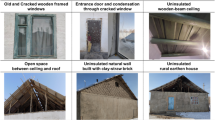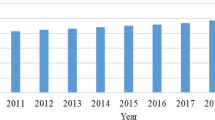Abstract
Before Eco-Niwas Samhita (ENS) 2018, India lacked a formal code for building energy performance, leading to outdated regulations on floor space. The Eco-Niwas Samhita (ENS) 2018 allows architects to create low-energy buildings by breaking down spaces into three categories: openable window to floor area ratio, visual light transmittance and overall heat loss/gain coefficient. The purpose of this study is to assess the code’s success in enhancing buildings’ thermal performance which reduces energy use and boosts occupant comfort. The evaluation is carried out in accordance with energy assessment rules, with an emphasis on classifying energy performance efficiency. Employing ENS as well as the universal energy performance index (UEPI), the study attempts to assess the energy efficiency of separately planned homes in Indian cities. These evaluations are carried out to establish the normalized yearly electrical energy consumption per unit of building space. Two case studies of residential buildings in Indore, Madhya Pradesh, meet the ENS code for 2018, but window shading and top slab insulation need scientific attention. This research makes an effort to close the gap between the two. A residential building complex in Indore City is examined for conformity with the Eco Niwas Samhita through the aid of this study. This research contributes to sustainable building practices and emphasizes the importance of adopting energy-efficient measures in construction projects. Policymakers, architects, engineers and developers can use this information to make informed decisions and support a sustainable and energy-neutral future. This analysis demonstrates how energy savings are feasible if the basic standards for energy efficiency are met by all typical buildings. It also emphasizes the potential savings that were otherwise lost since residential buildings were not subject to the same regulations. The findings of this investigation demonstrate the significance of encouraging sustainable practices in homes and provide evidence for the necessity of energy-saving measures. Retrofitting a building can contribute effectively and efficiently to the energy efficiency of the building.











Similar content being viewed by others
References
Bakre A, Diddi S, Sengupta A (2018) Eco-Niwas Samhita 2018 (energy conservation building code for residential buildings) Part I: building envelope, 1st edn. New Delhi, Bureau of Energy Efficiency (BEE), pp 2–11
Chand R, Srivastava SK et al (2015) A report on energy efficiency and energy mix in the Indian energy system 2030, using India energy security scenarios, 2047. NITI Aayog. Version 27/06/2017, New Delhi
Cheng C, Pouffary S (2008) The Kyoto protocol, the clean development mechanism and the building and construction sector—a report for the UNEP sustainable buildings and construction initiative, United Nations Environment Programme, Paris
Ebrahimi-Moghadam A, Ildarabadi P, Aliakbari K, Arabkoohsar A, Fadaee F (2020) Performance analysis of light shelves in providing visual and thermal comfort and energy savings in residential buildings. J Braz Soc Mech Sci Eng 42:484. https://doi.org/10.1007/s40430-020-02565-2
Evans M, Yu S, Staniszewski A, Jin L, Denysenko A (2018) The international implications of national and local coordination on building energy codes: case studies in six cities. J Clean Prod 191:127–134. https://doi.org/10.1016/j.jclepro.2018.04.142
Gasparin S, Berger J, Dutykh D, Mendes N (2019) An innovative method to determine optimum insulation thickness based on nonuniform adaptive moving grid. J Braz Soc Mech Sci Eng 41:173. https://doi.org/10.1007/s40430-019-1670-6
Groesser SN (2014) Co-evolution of legal and voluntary standards: development of energy efficiency in Swiss residential building codes. Technol Forecast Soc Chang 87:1–16. https://doi.org/10.1016/j.techfore.2014.05.014
Gundogdu E et al (2019) Effect of window glazing’s visible transmittance to daylight factor and energy efficiency in an architecture studio. In: Proceedings of the 7th international conference on embracing capacity building opportunities in the modern day dispensation, pp 466–472
Guo Q, Wu Y, Ding Y, Feng W, Zhu N (2016) Measures to enforce mandatory civil building energy efficiency codes in China. J Clean Prod 119:152–166. https://doi.org/10.1016/j.jclepro.2016.02.002
Gupta D, Pachuri RK (2010) Introduction to National Rating System. In: GRIHA Vol-1. TERI Press and Ministry of New and Renewable Energy, Government of India, Delhi, pp 13–17
Huang B, Mauerhofer V, Geng Y (2016) Analysis of existing building energy saving policies in Japan and China. J Clean Prod 112:1510–1518. https://doi.org/10.1016/j.jclepro.2015.07.041
Hui SCM (1997) Overall thermal transfer value (OTTV): how to improve its control in Hong Kong. In: Proceedings of the one-day symposium on building, energy and environment, Kowloon, Hong Kong
IEA, UNDP (2013) Modernising building energy codes to secure our global energy future: policy pathway, 70
IEA (2015) India energy outlook—world energy outlook special report. International Energy Agency, Paris
IPCC (2018) Global warming of 1.5°C—Chapter 2: mitigation pathways compatible with 1.5°C in the context of sustainable development. https://www.ipcc.ch/sr15/chapter/chapter-2/
Jaffe AB, Stavins RN (1994) The energy-efficiency gap What does it mean? Energy Policy 22:804–810. https://doi.org/10.1016/0301-4215(94)90138-4
Laustsen J (2008) Energy efficiency requirements in building codes, energy efficiency policies for new buildings. IEA Information Paper. Sweden
Lee JW et al (2013) Optimization of building window system in Asian regions by analyzing solar heat gain and daylighting elements. Renew Energy 50:522–531. https://doi.org/10.1016/j.renene.2012.07.041
Liu F, Meyer AS, Hogan JF (2010) Mainstreaming building energy efficiency codes in developing countries: global experiences and lessons from early adopters, vol 204, World Bank Publications
Levine M, de la Rue de Can S, Zheng N, Williams C, Thorne Amann J, Staniaszek D (2012) Building energy-efficiency best practice policies and policy packages, United States. https://doi.org/10.2172/1168594
Lucon O et al (2014) Buildings, in climate change 2014: mitigation of climate change contribution of working group III to the fifth assessment report of the intergovernmental panel on climate change, Edenhofer O et al (ed), Cambridge University Press, Cambridge
Muzumdar M (2002) Energy efficient buildings in India. Tata Energy Research Institute and Ministry of Non-Conventional Energy Resources, Delhi, pp 112–114
Mykytyak V (2015) The impact of window-to-wall ratio on energy intensity of existing office buildings in Ontario and Guebec, Toronto, Ontario
Ouahrani D (2010) Towards energy efficient buildings in Amman. Defining thermal requirements by means of thermal simulations, Jordan
Phuong NTK et al (2019) Window to floor ratio in the design stage in considering visual-thermal comfort and safety in building. In: IOP conference series. https://doi.org/10.1088/1757-899x/675/1/012010
Prasad G (2016) Letter No. 03/88/2015–16 GCRT, clause no. 2(iii), Government of India, Ministry of new and renewable energy, Delhi
Rashid M et al (2016) Effect of window wall ratio (WWR) on heat gain in commercial buildings in the climate of Lahore. Int J Res Chem Metall Civ Eng 3(1):122–125. https://doi.org/10.15242/IJRCMCE.AE0516031
Sadripour S, Mollamahdi M, Sheikhzadeh GA, Adibi M (2017) Providing thermal comfort and saving energy inside the buildings using a ceiling fan in heating systems. J Braz Soc Mech Sci Eng 39(10):4219–4230
Schwarz et al (2018) Addressing integration challenges of high shares of residential solar photovoltaics with battery storage and smart policy designs. https://doi.org/10.1088/1748-9326/aaf934
Ürge-Vorsatz D, Koeppel S, Mirasgedis S (2007) Appraisal of policy instruments for reducing buildings’ CO2 emissions. Build Res Inf 35:458–477. https://doi.org/10.1080/09613210701327384
Ürge-Vorsatz D et al (2012) Energy end-use: buildings. In: Johansson TB, Nakicenovic N, Patwardhan A, Gomez-Echeverri L (eds) Global energy assessment (GEA). Cambridge University Press, Cambridge, pp 649–760. https://doi.org/10.1017/CBO9780511793677.016
Vaishnani Y, Ali SF, Joshi A, Rakshit D, Wang F (2020) Thermal performance analysis of a naturally ventilated system using PMV models for different roof inclinations in composite climatic conditions. J Braz Soc Mech Sci Eng 42:124. https://doi.org/10.1007/s40430-020-2219-4
Visveswaraya HC, Suresh V (2016) National building code of India. Part 1. Bureau of Indian Standards (BIS), Delhi, pp 05–20
Zhai ZJ, Previtali JM (2010) Ancient vernacular architecture: characteristics categorization and energy performance evaluation. Energy Build 42(3):357–365. https://doi.org/10.1016/j.enbuild.2009.10.002
Author information
Authors and Affiliations
Corresponding author
Rights and permissions
Springer Nature or its licensor (e.g. a society or other partner) holds exclusive rights to this article under a publishing agreement with the author(s) or other rightsholder(s); author self-archiving of the accepted manuscript version of this article is solely governed by the terms of such publishing agreement and applicable law.
About this article
Cite this article
Yardi, V., Pandit, R.K. Effect of ENS Code Compliance on Performance of Building with Respect to Energy Performance Index. Iran J Sci Technol Trans Civ Eng (2023). https://doi.org/10.1007/s40996-023-01296-3
Received:
Accepted:
Published:
DOI: https://doi.org/10.1007/s40996-023-01296-3




